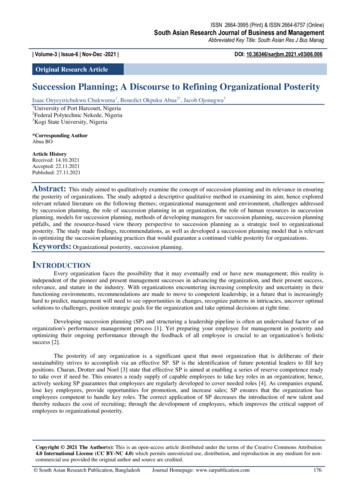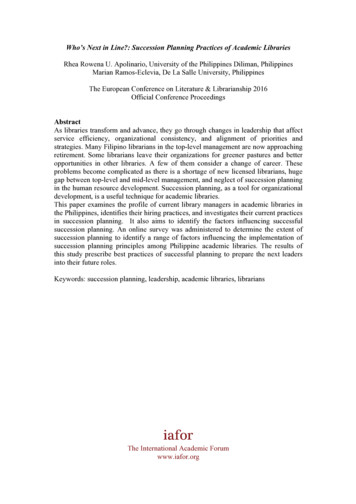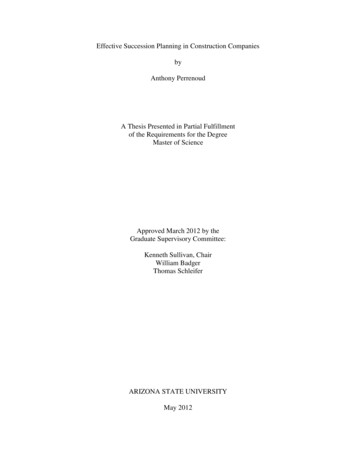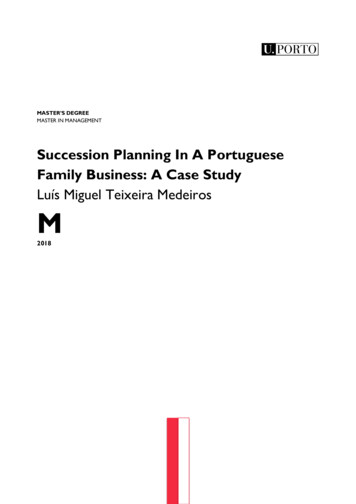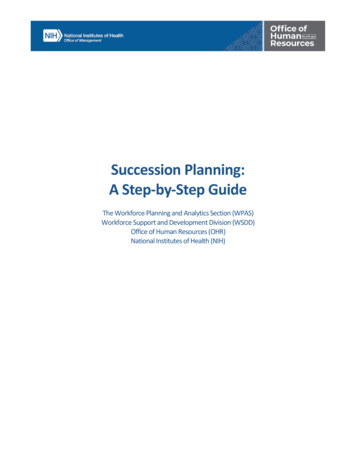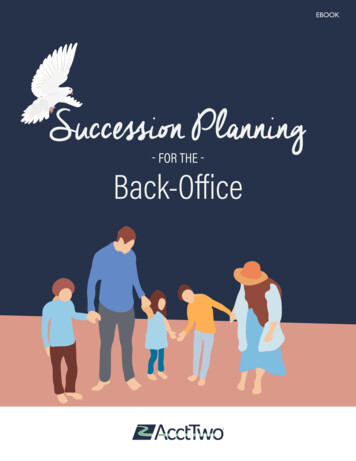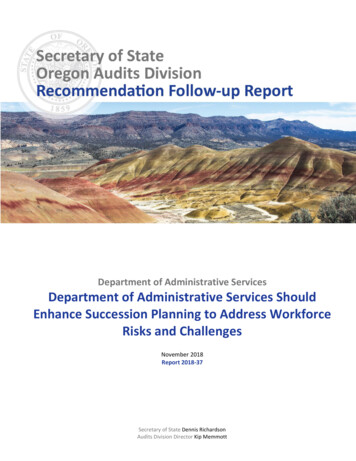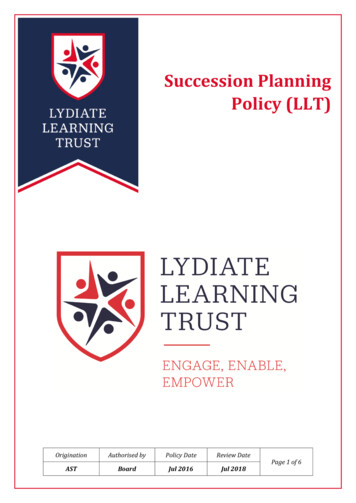
Transcription
The Importance of SuccessionPlanning for Financial AdvisorsFor Use With Financial Advisors Only. Not For Use With The General Public.
The Importance of Succession Planningfor Financial AdvisorsFinancial advisors frequently impress upon theirclients the importance of careful planning fortheir goals of tomorrow. Ironically, many have not yetaddressed their own critically important question:what will happen to their business when it comes timefor them to retire?Only a small percentage of advisors have formalsuccession plans in place — as few as 18 percent,according to a survey of 117 advisors by CLSInvestments.1 Another study by FPA Research andPractice Institute puts the number at about 25 percent.“ The percentage with a formal plan increases slightlyto 31 percent at age 60 to 64 and 41 percent at age65-plus,” said the study authors.2Though the data varies a bit, the picture is clear.The vast majority of advisors, even those nearingretirement age, have not developed plans for thenext leadership of their firm, nor for funding theirretirement after they step away from the business.Adding to the urgency of the question is the fact thatfor many advisors, their most valuable asset is thebusiness that they’ve built and nurtured over thecourse of their career – their advisory practice iswhere much of their net worth resides. One reasonadvisors avoid this vital planning may be that sellinga business is an emotionally charged issue. Manyadvisors enjoy their work and derive such satisfactionfrom caring for their clients that it’s hard to thinkabout retirement in the traditional sense, or to imagineever stepping away from their practice.SMALL PERCENTAGEOF ADVISORSHAVE SUCCESSION PLAN25%About 25% of advisors31%The numberincreases slightlyhave a formal succession planto 31% for ages 60-6441%And at age 65 , only 41%of advisors have a succession plan1 Nick Thornton, Younger Advisors Report High Levels of Job Satisfaction (BenefitsPro, March 24, 2015).2 The Future of Practice Management, conducted by FPA Research and Practice Institute, October 2013.2For Use With Financial Advisors Only. Not For Use With The General Public.
Advisors are not well preparedfor their own eventual transitionout of the business world.46 percentof financial planners surveyedadmitted to having no retirement plan.Industry is greyingEven so, the question of what the next chapter willhold is fast approaching. The average age of theapproximately 316,000 financial advisors in the industryis 51 years. About 43 percent of all advisors are overage 55, and about one-third are between the agesof 55 and 64, according Cerulli Associates of Boston.3As a profession, financial planning is expected toexpand by 27 percent over the next decade, dueto baby boomers retiring.4 At the same time, thefinancial services industry is set to undergo a waveof retirement and transfer of ownership as thefounding generation of baby boomer financial advisorsapproach their own retirement. Over the next decade,12,000 to 16,000 advisors are expected to retire everyyear,” according to a recent BenefitsPro article.5AGING ADVISOR COMMUNITYThe average age of the approximately316,000 financial advisors in the industry is 51 years.About 43 percent of all advisorsare over age 55, and about one-thirdare between the ages of 55 and 64.3 Nick Thornton, Younger Advisors Report High Levels of Job Satisfaction (BenefitsPro, March 24, 2015).4 Lisa Barron, Demand for Financial Advisors to Grow (BenefitsPro, February 24, 2014).5 Lisa Barron, Demand for Financial Advisors to Grow (BenefitsPro, February 24, 2014).The Importance of Succession Planning for Financial Advisors3
How will advisors fund their retirement?Financial advisors routinely ask clients to visualize how their lives will look five,10 and 20 years down the road, yet it’s easy to see that many financial advisorsare more focused on working and growing their businesses than on making plansfor future downshifting. As a group, advisors are not very well prepared for theirown eventual transition out of the working world. In a 2013 study by FPA Researchand Practice Institute, 46 percent out of the 2,400 financial advisors and employeessurveyed admitted to having no retirement plan for themselves. Yet, fully 40 percentsay they plan to retire within the next 14 years.6When asked how much money they need for retirement, 61 percent of respondentsto the CLS Investments survey estimated that they need at least 1.5 million, whileanother 42 percent said they need 2 million. Almost half of respondents said theywere less than halfway there. Only 11 percent said they were in a position to retirecomfortably.7HOW MUCH IS NEEDED FOR RETIREMENT? 1.5M61% of financial advisors believe 2M42% of financial advisors believeADVISORS BEHINDIN RETIREMENT SAVING 1.5 million is needed for retirement 2 million is needed for retirement50%saved half of what theyestimate they willneed in retirement6 FPA Research & Practice Institute, The Future of Practice Management (2013).7 CLS Investments, LLC - CLS Advisor IQ Series, Reinvent Your Practice: Alternatives to Traditional Succession Planning (2014).4For Use With Financial Advisors Only. Not For Use With The General Public.11%saved enoughto retirecomforably
It’s clear that succession planningis important in many ways – for thesake of continuity of care for clients,for regulatory compliance purposesand of course, for providing fundsfor the advisor’s retirement.On the other hand, reaching a “magic number” by a certain date is not the onlypossible solution to the retirement conundrum. For a combination of social,financial and personal reasons, the boomer generation has reimagined theirretirement lifestyle to include at least some work. Rather than endless golfcourses and sunning on the beach, the boomer trend looks more like a downshiftingthan an ending. Many boomers aspire to shift to more satisfying work that cancontinue into their 70s and beyond.This trend fits well with the typical advisor profile, since many advisors feel that theiridentity is closely wrapped up with working and their relationships with their clients.Providing Continuity of care for clientsAnother approach to the topic of succession planning is to think in terms of businesscontinuity: What would happen to the advisor’s clients, employees and family in theevent of the unexpected absence of key personnel in the firm, or a natural disasterof some sort?Business interruptions can take many forms, including the sudden death ofa principal, a natural disaster such as Hurricane Irene of 2011 or Hurricane Sandyof 2012, a political situation or a cybersecurity threat. Advisors owe a fiduciaryduty to their clients to have an up-to-date plan describing the steps that a firm willtake to protect their accounts in case normal service is interrupted. Investors areexposed if their advisors don’t have contingency plans in place. “ it makes goodbusiness sense to develop succession plans, and particularly so as investmentfiduciaries,” said Duane Thompson, senior policy analyst at the fiduciary trainingfirm fi360, to Financial Planning.88 Kennith Corbin, Got a Succession Plan? State Regulators May Soon Require It (Financial Planning, April 23, 2015).The Importance of Succession Planning for Financial Advisors5
Regulatory pressure for business continuity and succession planningRegulatory drivers add yet another layer to the question of succession planningfor financial advisors. NASAA, the association of state securities regulators,published a model rule in April, presenting a uniform set of requirements forbusiness continuity and succession plans to protect investors from unexpectedcircumstances.9 The SEC is also concerned about the vulnerability of investorsin the event of unusual business disruptions.The model rule, which states can consider for adoption, essentially requiresadvisors to have formal plans in place for backing up and recovering recordsand for communicating with customers, regulators, employees and vendorsin case of a significant business interruption. It also asks for a succession plandesignating who would assume key responsibilities in the event that seniorleaders become incapacitated.10 The likelihood that many states may adopt thismodel rule makes business continuity planning and succession planning evenmore of a pressing topic for financial advisors to address.Succession planning can unlock more business valueIt’s clear that succession planning is important in many ways — for the sakeof continuity of care for clients, for regulatory compliance purposes and of course,for providing funds for the advisor’s retirement. On this last front, the ultimateworth of an advisory practice can vary greatly depending on how the advisor’s exitis structured.Even a thriving practice with relatively strong revenue may not fetch enoughin the market to fully fund a comfortable retirement. The average annualincome for an advisor is around 160,000, while the average sale price fora practice is about 500,000. Obviously that leaves quite a gap when it comesto meeting a retirement goal of around 1.5 million to 2 million. Accordingto the CLS Investments study, it appears most advisors are counting on thesale of their business to fund their own retirements. In fact, 40 percent saidthey expect the proceeds to generate 26 to 50 percent of what they will need.9 NASAA Model Rule on Business Continuity and Succession Planning Model Rule 203(a) - 1A or 2002 Rule 411(c) 1A (Adopted April 13, 2015).10 NASAA Model Rule on Business Continuity and Succession Planning Model Rule 203(a) - 1A or 2002 Rule 411(c) 1A (Adopted April 13, 2015).6For Use With Financial Advisors Only. Not For Use With The General Public.
Just a small fraction of survey respondents —14 percent — were confident that the proceeds ofa sale would generate all of their retirement income.11PROCEEDS FROM SALE OF PRACTICEDO NOT MEET RETIREMENT FUNDING NEEDSThis situation suggests that a straight sale atretirement age may not be the most viable optionfor many independent advisors. Some experts believethat advisors who seek to sell their firms won’t getthe price they’re after — and would be much betteroff if they delay retirement as long as possible.12Yet if an advisor delays retirement for too long, thefirm may begin to lose value as the average age ofthe client base goes up and the asset base goes down.To get more value out of a sale, advisors may wantto consider a variety of deal structures beyonda traditional sale. A well-conceived successionplan can add value by providing for the continuationof the firm as the founder begins to step backand leadership transitions to the next generation. 160,000Average annual income 500,000Average sale priceEXPECTED SALE VS. RETIRMENT SAVINGS GOAL26%50%Funds still needed40% of advisors surveyedexpect the sale of their practice to generate 26% to 50%of what they need for retirement savings.14% of advisors surveyedexpect the sale of their practice to fully fund theirretirement savings.11 CLS Investments, LLC - CLS Advisor IQ Series, Reinvent Your Practice: Alternatives to Traditional Succession Planning (2014).12 Ann Marsh, Alternative Strategy for Retirement: Don’t, (Financial Planning, August 27, 2014).The Importance of Succession Planning for Financial Advisors7
Types of deal structuresWorking on a succession plan well ahead of the desired retirement date allows formore planning options and can add significantly to the advisor’s total compensation.These days, advisors have many options for structuring a sale and more flexibilityas far as financing, front- and back-end payments, and collaboration. “The newtrend in the industry is longer term transitions where both the buyer and sellerwork collaboratively for three to five years after the sale has occurred,” accordingto a study by Succession Resource Group (SRG), commissioned by Ameriprise.13Longer transitions offer the retiring advisor the opportunity to earn additionalincome for retirement by helping the successor for a period of time.Here is a look at some general types of deal structures.Traditional saleIn a traditional sale, the advisor sells the book of business in one single transaction.During a fairly short period of collaboration – typically six to 18 months – the sellerhelps smooth the transition of clients to the buyer.Factors that can affect the valuation of the deal include: length of tenure of clients,average age of the clients, account assets, non-recurring and recurring revenuesources and the growth rate of the firm. Experts say down payments can range fromapproximately 15 percent to 40 percent, depending on the quality of the business. Thebalance of the sale price is financed by a promissory note or earn-out arrangement.Valuations can range from roughly one- to three-and-a-half times revenue.14Gradual or partial book saleAn advisor may wish to monetize a portion of their business by selling a certainsegment of clients, commonly to buyer within the same broker dealer network, whileretaining the balance of the accounts. This is known as a partial book sale. Afterclosing the deal, a period of collaboration between the seller and the buyer canextend for three to five years. This strategy allows the seller “to judge the success/failure of the deal before transitioning their ‘A’ clients to the buyer,” according to SRG.13 Deal Structuring and Succession Trends for Advisors, Succession Resource Group (2012).14 Deal Structuring and Succession Trends for Advisors, Succession Resource Group (2012).8For Use With Financial Advisors Only. Not For Use With The General Public.
The new trend in the industryis longer term transitions whereboth the buyer and seller workcollaboratively for three to fiveyears after the sale has occurred.— From a study by Succession ResourceGroup (SRG) commissioned by AmeripriseSell and stayIf the advisor wants to transfer ownership of the business but continue working fora period of time, the deal can usually be structured as a type of merger, or a “selland stay”. In this case the advisor sells the book of business but continues workingwith the same clients through a contract with the buyer. The seller receives a downpayment at closing, an employment contract for the collaboration period, and apromissory note for the balance.Internal successionAn advisor may envision one day handing over the reins of the business to a juniorpartner. Internal succession — meaning the practice is sold over time to anemployee, family member or team — is becoming popular, especially with smallerfirms. Such deals are complex to plan, but can yield rich benefits for all parties.Many advisors care greatly about ensuring the continuity of the firm they’ve builtand value the idea of finding a successor among trusted associates.It is often the case that the junior advisor does not have much capital available,or may not be experienced enough yet to assume the lead role. Also at issueis whether a firm is ready to be sold. It may be that much of the value of an advisoryfirm is closely tied to the active participation of the founder.An internal succession can be planned over a number of years, giving time foran advisor to groom and develop the successor, install a strong team, and fosterclient relationships with the new person or team who will eventually become thenew leadership. When succession planning begins well in advance of the advisor’splanned retirement, the advisor gains greater ability to ease out gradually whilepreserving the company’s value and setting it up for continued growth. The ownercan delegate some responsibilities while staying hands on with a smaller groupof top clients. This strategy can be more enjoyable and help the senior advisoravoid burnout.Unlike an outright sale, an internal succession involves a long collaboration period.Often the junior advisor pays little or nothing upfront, and the senior advisorextends financing over a long period that can span as long as 10 years. The successorpays off the debt over time; meanwhile the founder receives an income stream fora longer period.The Importance of Succession Planning for Financial Advisors9
When succession planning beginswell in advance of the advisor’splanned retirement, the advisor gainsgreater ability to ease out graduallywhile preserving the company’s valueand setting it up for continued growth.By identifying a successor well in advance, the advisor may reap the benefitsof a satisfying later career while preserving more value and growth potentialfor the firm.Preparing to let goConsidering the complexity of decisions surrounding succession planning,it’s no surprise many advisors avoid thinking about the process. Part of thechallenge involves an emotional process of letting go that some may notbe ready to face. After all, financial planning is by its very nature a hand-onendeavor. “It’s no secret that successful independent financial advisorsare control freaks. The draw toward independence in our industry startswith the appeal of being the boss,” explains Jason Card of J.W. Financial,in a recent Financial Planning article.Naturally, there may be some resistance to the very notion of one day no longerbeing the boss. Card adds that throughout the industry, in order to preparetheir businesses to thrive after they’ve left, advisors need to set up systems thatallow them to release control. “You’re trying to sell a business, not your ownwork — because, after all, the idea is to eventually stop working.”1515 Jason Card, Not Quite Ready to Sell Your Firm? Here’s How to Get There. (Financial Planning, April 27, 2015).10For Use With Financial Advisors Only. Not For Use With The General Public.
ConclusionWithout a well-executed succession plan, many independent advisory firmsmay fall victim to the most common of small business fates – which is notto outlive the founder. The same independent spirit which drew the financialadvisor to start a practice can become a hindrance when it comes to sellingthe business. A succession plan preserves the value of the firm by determiningan orderly way for the founding advisor to step back and allow the nextgeneration of leadership to step up.When thinking about the long-term future of a financial advisory practice,starting the process far in advance will preserve more options and allow moretime for identifying the right successor or team. Prudent succession planninghelps the financial planner provide the firm with a smooth transition that is bestfor clients while increasing the income stream for retirement.The Importance of Succession Planning for Financial Advisors11
www.adp.com/401kADP Retirement Services71 Hanover RoadFlorham Park, NJ 07932Make Retirement EasyADP Retirement Services helps you take the challenge out of retirementadministration for your clients. For more than a decade, we have been helpingadvisors like you create successful retirement plans by:1. Making retirement administration easy to manage.2. Helping your clients and their employees become retirement ready.3. Keeping our interests aligned with yours—and those of your clients.Contact our financial advisor sales support desk formore information at 844-ADP-ELITE (844-237-3548).About ADPEmployers around the world rely on ADP (NASDAQ: ADP) for cloud-based solutions and services to help manage their most important asset – their people. From humanresources and payroll to talent management to benefits administration, ADP brings unmatched depth and expertise in helping clients build a better workforce. A pioneerin Human Capital Management (HCM) and business process outsourcing, ADP serves more than 625,000 clients in more than 100 countries. ADP.com.This white paper has been prepared by SourceMedia on behalf of ADP Retirement Services and the surveys, studies and other resource materials cited herein have beenprepared by and are the property of the third parties named herein and are accurate as of April 30, 2015, or as the date of the material’s publication, as applicable. The viewsexpressed in this publication are those of the author, are intended for general information only and are not intended to provide investment, financial, tax or legal advice ora recommendation for any particular situation or plan, nor is this publication the sole authority on any regulation, law or ruling. ADP, LLC and its other affiliates (ADP) do notoffer investment, financial, tax or legal advice, are not responsible for the content of, nor have any of them verified the accuracy of, any information obtained or the methodologyused by such third parties or published in this white paper. Any information provided by ADP or its representatives to you is not to be construed as, nor should it be deemedto be, comprehensive or particularized advice or guidance. Please consult with your own investment, financial, tax and legal advisors to the extent you deem appropriate in lightof your own circumstances.The ADP logo and ADP are registered trademarks of ADP, LLC. All other trademarks andservice marks are the property of their respective owners.99-3843-0715 Copyright 2015 ADP, LLC ALL RIGHTS RESERVEDFor Use With Financial Advisors Only.Not For Use With The General Public.
The Importance of Succession Planning for Financial Advisors 7 11 CLS Investments, LLC - CLS Advisor IQ Series, Reinvent Your Practice: Alternatives to Traditional Succession Planning (2014). 12 Ann Marsh, Alternative Strategy for Retirement: Don't, (Financial Planning, August 27, 2014). Just a small fraction of survey respondents —


